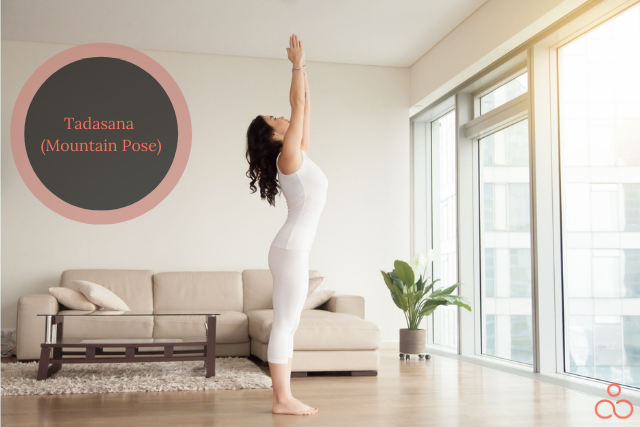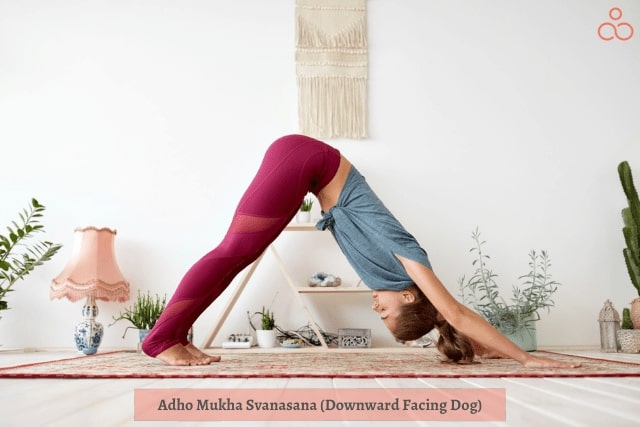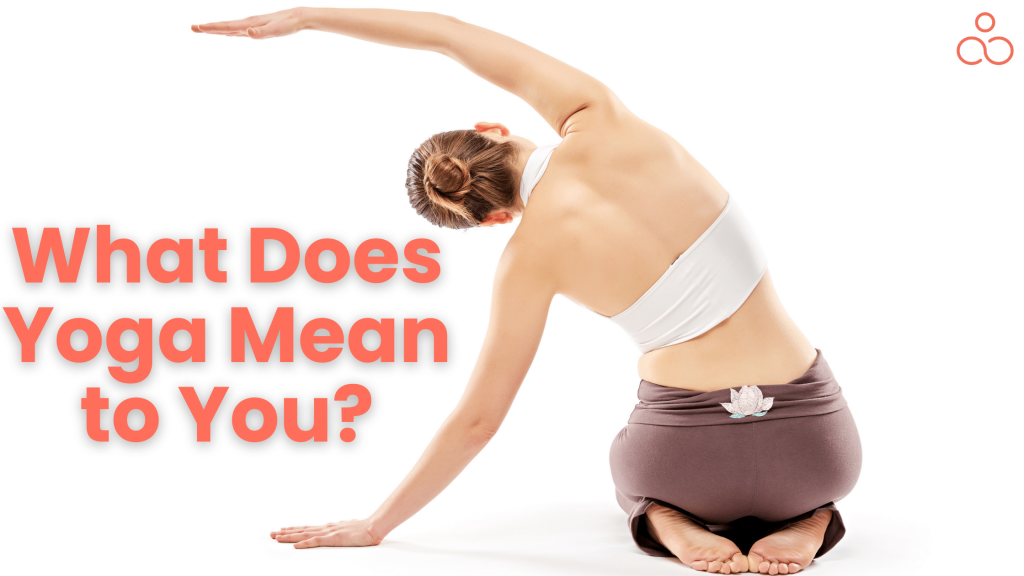Yoga is much more than just a set of asanas; it is a way of life that involves forming a deeper connection with your inner self, thus improving your quality of life. Every individual has a unique perception of “what does Yoga mean to you?”
Yoga has evolved over the years. While it is now often associated with contortionism and stretching exercises, it is essential to remember that traditional Yoga was never about flexibility or how many poses one could do. Instead, it was a spiritual practice that connected the body and mind.
Modern postural Yoga classes have taken on a more fitness-oriented approach, incorporating elements of gymnastics and bodybuilding. However, this doesn’t mean that the spiritual aspect of Yoga has been lost. Many practitioners still find solace in the practice and use it to connect with their inner selves. Whether you seek a physical workout or a spiritual exploration, Yoga can offer both combinations.
What does Yoga mean to you? Are you interested to learn about Yoga?
Yoga is a powerful tool that can help you stay grounded during difficult times, celebrate with you during the good times, and provide healing during sad times. It serves as a haven of quiet and serenity when you need to find calm and a source of vigor and inspiration when you need to feel uplifted. Through Yoga, you can take a moment to pause and live in the present moment, breath by breath.
The True Meaning of Yoga
Yoga is an age-old practice with origins in India’s Vedic era. It has been in existence and practiced for thousands of years. “Yuj“, the Sanskrit equivalent of the English term “Yoga,” means “to unite,” “to join,” or “to yoke.” This connection must be physical and spiritual to bring the sannyasin (a Hindu ascetic who lives a life of renunciation and spiritual seeking) closer to the atman (the innermost self or soul of an individual), the universal awareness. Yoga practice can help you develop a deeper understanding of your physical and spiritual body and learn how to live a more harmonious and balanced life. Yoga can aid in fostering a sense of inner calm and well-being by fusing the body, spirit, and mind. This union helps you attain “Samadhi“, a state of meditative absorption where you become aware of the Divine and yourself as one. Quite Wonderful, isn’t it?
The Origins of Yoga
Most people know that Yoga originated in India, but this is only a small chunk of the story. According to archaeological evidence, the Indus Valley Civilization may have practiced some form of Yoga asana, namely sitting meditation postures. This civilization was prosperous between 5000 and 3500 BCE. According to researchers, Yoga may have existed as an unwritten, oral tradition for many generations before the creation of the yogic wall art.
Yoga is an ancient old discipline, the origins of which are unknown. The spiritual traditions of Yoga have flourished throughout the Indian subcontinent, the Himalayas and even expanded to Southeast Asia, China, and Japan in the diverse manifestations of Hinduism, Buddhism, Sikhism, Jainism, and Sufism too.
The Mythological Genealogy of Yoga
One of Lord Shiva’s names or titles in the Hindu pantheon is Adiyogi or The Source of Yoga. According to legend, Lord Shiva visited Mount Kailash in the Himalayas some 15,000 years ago. He was so overcome with delight that he danced wildly, and when the excitement got too overwhelming, he could not show it in any other manner than by sitting in silent stillness.
Without getting up, he sat still and meditated. You would have assumed he was dead if it weren’t for the occasional tears of pure happiness from his closed eyelids.
A lot of people were interested in learning from him since they could see that he was doing something remarkable. So they came and sat down next to him. But he ignored them.
Even though Lord Shiva appeared to be ignoring them, they showed their devotion by dedicating 84 years to sadhana or rigorous spiritual practice to obtain the wisdom of the Adiyogi.
Finally, the seven eventually started to shine so brightly as a result of their many years of devotion. They were prepared to receive the lessons. Shiva was no longer able to ignore them. He assumed the role of the Adi Guru or the first Guru. And the seeds of Yoga were entrusted to these seven to be dispersed across the globe. The Saptarishis are the seven guys in question. They passed on Yoga since Lord Shiva had handed it down to them personally.
The Tradition and Transmission of Yoga
Anyone can study and practice Yoga, regardless of race, class, or religion. In modern times, a Yoga teacher may be awarded a certificate after completing specific hours of intensive instruction. But this does not entitle them to the title of “Yogi” or “Guru.” According to tradition, written scholarly publications are less significant than the oral heritage of Yoga. Even the Yoga Sutras of Patanjali, often regarded as the final word on Yoga, were intended to be a reference for Yoga instructors who had previously learned the oral traditions from a master and not to be used independently.
Yoga is believed to have been transmitted directly from teacher to pupil from the time of Adiyogi, Shiva, through a process known as “Shaktipat”, or the descending of Shiva’s grace. Through this transmission, a student acquires the Guru’s wisdom and heritage and passes on these teachings to others.
The role of mindfulness in yoga practice. How can yoga improve overall well-being?
Yoga has been known to improve overall well-being, but the role of mindfulness in this practice should not be overlooked. Mindfulness practice involves being fully present in the moment and attentive to your thoughts and feelings without judgment. When applied to yoga, it can deepen your practice and increase the benefits.
Focusing on your breath and body sensations allows you to cultivate a deeper sense of inner peace and calmness and feel a deeper connection to yourself and your practice. Mindfulness can also help reduce anxiety and stress, which are common obstacles to achieving overall well-being. So, the next time you hit the mat, try incorporating mindfulness into your practice and see how it can enhance your overall experience.
Therefore, Yoga is an excellent way to practice mindfulness, as it involves both physical movement and mindful breathing. By bringing our attention to our breath and our body, we can fully immerse ourselves in the practice of yoga and experience its many benefits. So if you’re seeking to improve your overall well-being, consider incorporating mindfulness into your yoga practice.
Explore The Important Benefits Of Yoga: Physical, Mental and Emotional!
Yoga is a practice that offers numerous benefits for physical, mental and emotional well-being. Let’s examine each of these benefits:
Physical Benefits
Yoga can help improve flexibility, strengthen muscles, increase blood flow, and decrease inflammation. Regular practice can also reduce the risk of injury and improve overall physical fitness.
Mental Benefits
Yoga can help reduce stress, anxiety, and depression. It can also improve focus, concentration, and overall cognitive function. Regular practice can help you feel more balanced and centered.
Emotional Benefits
Yoga can help promote feelings of peace, contentment, and self-awareness. It can also help you connect with others and develop a stronger sense of empathy and compassion.
So, whether you’re looking to improve your physical health, find inner peace, or simply reduce stress, Yoga is a great practice to explore!
The Different Types Of Yoga And Their Unique Benefits
Yoga can help improve flexibility, strength, balance, and mental clarity. It’s a gentle and adaptable exercise that’s great for all fitness levels and abilities. Whether you are just a newbie or an experienced yogi, there’s a yoga routine that’s perfect for you. Plus, practicing Yoga regularly can help reduce stress and improve overall well-being.
In recent years, the practice of Yoga has exploded in popularity, and for a good reason. There are numerous kinds of Yoga, each with its own set of benefits. Let’s dive into some of the most well-known types of Yoga and what distinguishes them:
- Hatha Yoga
This is the most basic form of Yoga and is excellent for beginners. It focuses on basic postures and breathing methods to help improve flexibility and relaxation.
- Vinyasa Yoga
This type of Yoga is more fast-paced and focuses on flowing movements that are synchronized with the breath. It’s excellent for building strength and improving cardiovascular health.
This is a more intense form of Yoga involving a set series of poses done in a specific order. It’s excellent for building strength and endurance.
- Iyengar Yoga
This is a popular kind of Yoga that is distinguished by its use of props (such as blocks, straps, and bolsters) to help the body achieve optimal alignment in each Asana (posture).
- Bikram Yoga
Also known as hot Yoga, this type of Yoga is done in a heated room and involves a specific series of 26 poses. It’s excellent for improving flexibility and detoxifying the body.
- Restorative Yoga
This type of Yoga is all about relaxation and stress relief. It involves gentle poses held for extended periods to help calm the mind and body.
Incorporating Yoga into your daily routine can provide numerous benefits, regardless of the type you choose. From increased flexibility and strength to improved mental clarity and stress relief, Yoga is an excellent method to enhance your overall health and well-being.
Unlock the full potential of your yoga practice with the eight limbs of yoga. Elevate beyond physical postures and discover the boundless benefits of this ancient art!
Click on the link to inspire and enlighten yourself with the wisdom of yoga:
Some Popular Ways To Study Traditional Yoga In The Modern World
In today’s fast-paced world, traditional yoga practices can be difficult to find. However, there are many ways to study and practice yoga in modern times. One popular option is to attend a yoga class at a local studio or gym, where you can learn from a trained instructor and connect with other like-minded individuals. Another option is to take an online course or watch instructional videos, which can be a convenient way to practice yoga from your home. Additionally, many yoga retreats and workshops are available worldwide, offering a deeper immersion into traditional yoga practices and teachings. Whatever your preferred method, there are many ways to incorporate yoga into your daily life and reap its benefits.
1. Learn from a Guru
Traditionally, a Guru has received Shaktipat from a lineage of Gurus. All the ancient texts about Yoga point out the importance of studying under a Guru who understands how to teach the tradition without changing it but using the vernacular of modern times. Although not all Yoga teachers today have received this transmission, many teachers have studied for years with masters and received their blessings to share the teachings in the west. Some famous Indian Gurus have used modern technology to reach millions of students worldwide. Spiritual leaders like Sadhguru and Mooji regularly broadcast their satsangs or spiritual teachings. Other teachers like Mata Amritanandamayi Devi or Alv Kumar have been able to set up online learning portals to teach Yoga in the traditional way using modern mediums.
2. Be part of a community
Yogis in the past were renunciates who turned away from the world because they thought it was all an illusion. However, even in ancient times, some people understood that even if they wanted to practice and learn Yoga, they still needed to be part of society. These people were known as householders, and the support of a sangha—a group of like-minded people—made it feasible for them to learn and practice Yoga. A sangha can be a community of ordained Buddhist monks who reside in a monastery together or a gathering of friends who sing kirtan together once a week. The shared aim of Yoga is what unites a sangha.
3. Read the Yoga Sutras of Patanjali
Despite being performed and transmitted for thousands of years, Yoga wasn’t formalized into a text until some time in the second century C.E. by a mythological sage named Patanjali.
Although it was not the first literature on the Yoga Sutras, it has influenced modern Yoga practices the most.
One of the difficulties with studying the Yoga Sutras is that non-Sanskrit speakers must rely on a translator’s interpretation of the text to comprehend it. This depends on the translator’s knowledge and preferences, which is an issue with the translations of many old writings. It is crucial to study Patanjali’s Yoga Sutras under the direction of a guru who has the blessings and lineage of oral teachings that were never documented in written form, notwithstanding the importance of reading as many different versions as you can.
4. A Pilgrimage to India (or other Sacred Sites)
There comes the point in many Yoga practitioners’ journey that the pull of India becomes too strong. Many flock to holy places like Rishikesh in North India, where the Beatles went on pilgrimage in the 1960s to follow their Guru, Maharishi Mahesh Yogi. These sacred sites of pilgrimage have been mentioned in mythology and the Vedas, ancient sacred scriptures from India. They include the holy rivers, the most famous being the Ganges River which traverses most of the sub-continent and has nourished hundreds of civilisations since prehistory. Other places include sites where temples have been built where Lord Shiva’s tears fell or where drops of Kali Ma’s blood fell.
Outside India, Yoga practitioners can also deepen their practice at other sacred sites like Tibet, Nepal, Bali, Uluwatu in Australia, or other energy centers where spiritual seekers have gathered. Going on a pilgrimage to these holy sites is a natural part of a Yoga student’s spiritual journey and studies. It is an opportunity to meet others who walk a similar path and learn from other teachers and masters who live and teach at those temples and holy places.
5. Keep Practicing Modern Postural Yoga
No doubt modern postural Yoga practices do not resemble Yoga as the spiritual path it originally was. But Yoga practiced at fancy studios and gyms today still has its merits. Yoga prepares your body for the stillness of meditation, allowing you to be healthy and live a more stress-free and content life. Even as a secular, non-spiritual practice, Yoga remains popular because you do not necessarily have to believe in any of its spiritual or even esoteric elements to reap its benefits.
The scientifically proven benefits of having a regular Yoga practice are numerous and include the following:
- Relieving stress, lower back pain, and menopause symptoms
- Managing anxiety and depression
- Helping people quit smoking
- Improving the quality of life for individuals experiencing chronic illness and pain
- Additionally, Yoga can help you develop healthy habits that will benefit you in the long term
Regular practice allows you to experience improved physical and mental well-being and a greater sense of peace and contentment.
Some recommended tips on how to practice Yoga
Yoga is traditionally part of one’s sadhana or disciplined spiritual practice. Whether you want to deepen your spiritual practice, stay active and healthy, or simply find a way to relax and de-stress, Yoga can be a great way to achieve your goals.
To maximize the advantages of your Yoga practice, consider the following suggestions:
1. Put Yoga on your schedule
Be sure to set aside some time each day for your yoga practice, whether you choose to practice asana or meditation and make it a priority. Doing this allows you to maintain consistency and get the most out of your practice.
2. Refrain from over-exerting yourself
Yoga is not a competitive sport. Don’t push your body too hard into an asana it isn’t ready for; instead, pay attention to your body.
3. Keep yourself nourished and hydrated
You will benefit more from your Yoga practice if you eat nutritious food and drink plenty of water.
4. Dress comfortably for movement
Choose comfortable clothes that won’t restrict your movement.
5. Take the instructor’s advice into consideration
Pay attention to your instructor’s cues and advice. Even minor changes can have a significant impact on your practice.
6. Always keep in mind that Yoga is more than just postures
Traditional Yoga is a whole life science. Incorporate the other aspects of Yoga, such as meditation, service, and living without judgment or attachment to your ego.
Some Personal Stories Of The Impact Of Yoga On Well-Being
Yoga has been known to have a positive impact on both physical and mental well-being. Here are some personal stories of individuals who have experienced the benefits of Yoga:
- “I have always had back pain, but after practicing Yoga consistently, I have noticed a significant decrease in my pain levels. Yoga has helped me strengthen my core and improve my posture, which has positively impacted my overall physical health.
- “Yoga has been such a lifesaver for me during times of stress and uncertainty. It has taught me to quiet my mind and focus on the present moment, which has helped me feel more grounded and centered.”
- “I started practicing Yoga regularly about a year ago, and it has made a huge difference in my life. Not only has it improved my flexibility and strength, but it has also helped me manage my anxiety and stress levels.”
- “After going through a difficult breakup, I turned to Yoga as a way to heal and find peace. The mindfulness and meditation practices have helped me release any negative emotions and focus on self-care.”
- “I have always struggled with sleep issues, but since incorporating Yoga into my routine, I have observed a remarkable enhancement in the quality of my sleep. The relaxation techniques and deep breathing exercises have helped me fall asleep faster and maintain a deeper slumber for an extended period.”
These are just some examples of the numerous ways in which Yoga can improve your well-being. Whether you are dealing with physical pain, mental health struggles, or simply looking to cultivate more mindfulness in your life, Yoga can be a powerful tool for transformation. If you are interested in trying Yoga for yourself, many resources are available online and in-person classes in most communities.
FAQ’s
Why is Yoga so crucial?
Anyone who practices Yoga regularly can see a long-lasting improvement in their lifestyle.
- Regular Yoga practice can aid in improving your body’s flexibility and relaxation.
- It helps to alleviate emotional discomfort and chronic tension.
- Yoga aids in the physical development of power, endurance, stamina, and high energy.
- On a mental level, it also strengthens oneself and promotes inner and outer harmony by enhancing attention, tranquility, quietness, and contentment.
What are the advantages of Yoga?
- Yoga improves breathing patterns and makes the body more flexible.
- It can control blood flow and aid in strengthening muscles.
- Regular Yoga practice boosts immunity and keeps illnesses at bay.
List a few simple Yoga postures
- Padmasana (sitting pose)
- Tadasana (mountain pose)

- Balasana (Child’s pose)

- Uttanasana (Standing Forward Bend)
- Adho Mukha Svanasana (Downward-Facing Dog)

Conclusion
According to Yoga teachers, Yoga has existed since the beginning of civilization. Although its origins are unknown, thousands of individuals have followed it as a spiritual path over the centuries. After reading this article, you might have a simple idea about “how does Yoga influence your well-being?” or think about your own opinion on “what does Yoga mean to you exactly?”.
Modern postural Yoga is the most recent development of this practice, handed down from teacher to student. Even though taking part in modern Yoga courses has advantages, finding enlightened masters and instructors of traditional Yoga can help you learn more about Yoga and your true self. Doing this will give you a deeper connection with your inner self and a better understanding of the historical practice and its numerous advantages.

